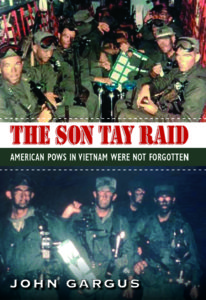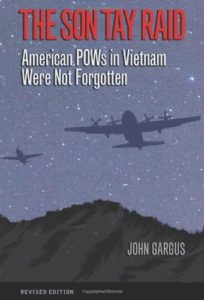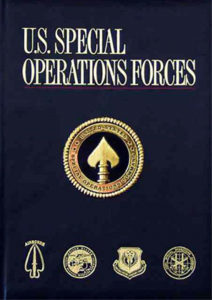Today’s military historians agree that even though the joint special operations raid on Son Tay did not free any Americans it was so meticulously planned, diligently rehearsed, and perfectly executed that it became a great tactical success. Its boldness stunned the North Vietnamese and showed the whole world that our soldiers in captivity were not forgotten and that we had able men who could eagerly carry out such a hazardous mission. I was honored to be one of them as an air operations planner and a navigator on one of the escorting aircraft.
Read my account of the raid in my book:
 First edition Hardback |
from the publisher: The Son Tay Raid from Amazon.com: The Son Tay Raid |
 Second edition Paperback |
I am also the author of Combat Talons in Vietnam – Recovering a Covert Special Ops Crew in which I wrote about the first operational deployment of this still magnificent aircraft, its challenging highly classified missions, its first aircraft loss over North Vietnam, and the long overdue recovery of its eleven crewmembers.
 |
from the publisher: Combat Talons in Vietnam – Recovering a Covert Special Ops Crew from Amazon.com: Combat Talons in Vietnam – Recovering a Covert Special Ops Crew |
Back jacket cover book endorsements:
“Only a very few have properly recorded the quiet and unheralded achievements of the Combat Talon aviation community. The noble aircraft, the dedicated flight and maintenance crews, and the exacting mission they performed are chronicled in this book. . . . enlightens and inspires and reminds us of those who served, and those who perished, pursuing excellence in special operations aviation.”— Gen. Norton A. Schwartz, USAF 19th chief of staff.
“Only those who served in the Stray Goose Project had a need to know about the first employment of Combat Talon technology in covert operations during the Vietnam War—and about the efforts of the quiet professional air commandos who executed hazardous missions inside of the most heavily defended enemy airspace. John Gargus tells the story of their lives and our nation’s commitment to return home the remains of all who made the ultimate sacrifice in the service of our country.”— Lt. Gen. LeRoy J. Manor, former commander, USAF Special Operations.
“A renowned MC-130 navigator and SOG veteran, no one could better have told the story of SOG’s top secret ‘Blackbirds’ than Col. Gargus. His book respectfully documents the 30-year effort to locate and account for the men lost on the only C-130 ‘Blackbird’ to have disappeared during the war. Well done, with much detail.”— Maj. John L. Plaster, US Army Special Forces and SOG Veteran
“Meticulously researched, Gargus resolves with dignity the mystery of the loss over North Vietnam of an eleven-member special operations C-130E Combat Talon crew and its eventual painstaking recovery.”— Forrest L. Marion, USAF Historical Research Agency.
“John Gargus weaves a tapestry of the little known events surrounding the loss of crew S-01 in 1967 and eventual interment at Arlington National Cemetery. He also reminds all Americans of the government’s efforts and programs to recover and return its fallen warriors from battlefields around the world.”— Herbert Mason, USAF Special Operations historian.
I am one of seven authors of the book U.S. Special Operations Forces. Its publication by Hugh Lauter Levin Associates, Inc. was conceived by Benjamin F. Schemmer, Editor-in-Chief for the Armed Forces Journal and John T. Carney, President and CEO for the Special Operations Warrior Foundation (SOWF). They assembled an outstanding team of distinguished active and retired special operations officers, historians, and experts to document our country’s elite special operations forces from the Revolutionary War Rogers Rangers to the post 9/11 forces in wars against the terrorists and their host countries.
Ben Schemmer recruited me to write a chapter on the Air Force Special Operations.
 |
This book is available from book stores and other vendors on the internet. Royalties provide funding of college scholarships for children who’ve lost a parent serving in Special Operations Command during an operational or training mission. |
Contents of the U.S. Special Operations Forces:
1. The Tip of America’s Spear by General Peter J. Schoomaker, U.S. Army (Ret), Commander of the United States Special Operations Command from 1997 to 2000. Recalled from retirement to serve as the 35th Chief of Staff of the United States Army from 2003 to 2007.
2. 1670-1941 Genesis and Unguided Growth by John M. Collins, U.S. Army (Ret), author of twelve books and many magazine articles on military topics and special operations.
3. 1942-1945 World War II Watershed by John M. Collins, U.S. Army (Ret),
4. 1946-1972 First Rejection and Reconstruction John M. Collins, U.S. Army (Ret),
5. 1973-1991 Second Rejection and Reconstruction by John M. Collins, U.S. Army (Ret),
6. U.S. Special Operations Command by Benjamin F. Schemmer, West Point graduate, editor of Armed Forces Journal International and editor-in-chief of Strategic Review.
7. U.S. Army Special Operations Command by John M. Collins, U.S. Army (Ret),
8. U.S. Air Force Special Operations Command by Colonel John Gargus U.S. Air Force (Ret), Combat Talon navigator instructor, mission planner and author.
9. U.S.Naval Special Warfare Command by Rear Admiral George R. Worthington, U.S. Navy (Ret), Commander of the Naval Special Warfare Command.
10. Theater Special Operations Command by Benjamin F. Schemmer.
11. Special Tools for Special Ops by Colonel John T. Carney, Jr., U.S. Air Force (Ret), innovative leader in the special operations community and the CEO of the SOWF.
12. Memorials and Museums by Roxanne Merritt, curator of the JFK Special Warfare Museum at Ft. Bragg, North Carolina.
13. Operation Iraqi Freedom by Colonel John T. Carney, Jr., U.S. Air Force (Ret),
Opening paragraph Air Force Special Operations Command’s chapter:
“Establishment of AFSOC on 20 May 1990 was a memorable event for the Commandos of all ages. Finally, after forty seven years of ad hoc existence that was marked by repeated activation, deactivation, and shuffling of special operations units among various Air Force major commands, they were grouped into a major command of their own. With it came a clearly defined role in the U.S. military doctrine to provide readily deployable unconventional warfare forces for the regional unified commands. AFSOC’s commanders would be three-star generals. The sustainability of their new command would no longer be a worrisome problem because under the equally new budgetary process they would not have to compete with other Air Force commands for scarce resources. They would receive their share of resources to forge a well-trained and well-equipped special operations air force that could support all challenges to the U.S. national interests in joint military operations, not only in war, but also in peace and in all levels of conflict in between, at “any time, any place.”
Editorial Reviews from the Internet:
1. I felt honored to have served with the most professional people in the military. [This book] truly does them justice. — Rudy Boesch, U.S. Navy (Ret.).
2. Most lavishly illustrated…books are short on substance, but this elegant overview contains a wealth of useful information… — General Wayne A. Downing, U.S. Army (Ret.).
3. Something to behold. It is filled with new insight….Ben Schemmer and his authors know what they are writing about. — Military Book Club.
4. Spectacularly illustrated, movingly written, U.S. Special Operations Forces puts a face to the heroes we never get to see… — Richard Steinberg, Special Ops Veteran and Novelist.
5. U.S. Special Operations Forces, in short, is a grand reference document as well as an easy read. –General Robert C. Kingston, U.S. Army (Ret.).
Books for Children
In 2023 Xlibris completed illustrating and printing books for children about a jungle school for young animals which I wrote for my two grandsons many years ago when they attended Montessori School of Rome in Georgia. They are available only from the printer www.xlibris.com or from other Internet book sellers.

Trouble in the Jungle
This is the first of five stories I wrote for my grandsons Dylan and Kemper while they were students at the Montessori School of Rome in Georgia. Their mother, Miss Dolores, was a schoolteacher there. She read this story to her class as a treat to her young students who heard Dylan boast that Papa wrote a story for him. This story about teasing, bullying, jealousy and showing off in a school environment became a huge success, not only with the students, but also with their parents who started wondering about what Miss Dolores was teaching them. Her students got their parents involved at home by asking them to pronounce words the way a snake would with their tongues sticking out of their mouths. They also loved the story once my daughter shared it with them. I took the liberty to call this jungle school the Monkeyssori School. They liked that name as well.
More Trouble in the Jungle
The second story continues with the same set of jungle characters. Little Gorilla MEG is too small to join others and is playing by herself in the sand by the Watermelon Rock. Giraffe ASHLEY comes to see what she is doing and her thin leg punches through a hole in the sand to an empty space below. She jumps back and Hippopotamus MOUUS comes to see what is happening. As he steps closer to MEG, the surface cover for an ancient well gives away under his weight and she falls through to the water 10 feet below Everyone panics. Little MEG is not injured, but she cannot swim. MOUUS is a good swimmer, so he tries to coach her about how to stay afloat. As before, Hyena RICK comes up with a solution. They summon SASS’s dad Python ZAZZ who is 20 feet long. He can reach down to MEG but can’t pull her out without slipping down into the well. MOUUS steps up to solve the problem. He provides anchor point for ZAZZ who wraps his neck around his foot and succeeds in pulling MEG out of the well. So, MOUUS, who had shamed himself in the first story, becomes a collaborative hero who had redeemed himself.
New Kid in School
This is the third of five stories I wrote for my grandsons. It is an educational story featuring a physically challenged newcomer, Turtle TUTTLE, who can barely walk because of his flattened butterfly-like feet. On his first day in school TUTTLE learns why birds can fly and becomes convinced that the same principles of flight should apply to him and that he should also be able to fly. Is he right?
Flying Turtle
This is an educational story intended for the fifth grade and older students. It features the same set of jungle characters as the previous stories and focuses on the flying experiences of Turtle TUTTLE – the new kid in school. He flies high over the jungle, chases a rainbow, and gets hopelessly lost. He spends the night trapped in tall grass where he landed after an exhaustive search for his home. He must chew his way out of the grass and find a jumping off place in a renewed search for his home. Finally, his bird friends find him and escort him back to the school for a joyous reunion with worried family and new friends.
What is a Rainbow?
This is the last one of the five stories I wrote for my grandsons. It is also an educational story intended for the fifth grade and older students. It became a logical, must-have sequel to the unusual flying experiences of Turtle TUTTLE. Miss Chimpanzee ANZIE must now teach the Monkeyssori students about what makes a rainbow and why TUTTLE could not catch up with one. The lesson becomes a participation event because all students learn that they can also make their own rainbows with water from the school pond.
Author’s Biography — John Gargus
John was born and raised in Czechoslovakia. When he was 15 years old his family helped him to escape from there to join his grandmother in Ohio. He obtained his Air Force commission through AFROTC in 1956 and became a navigator. He served in Military Airlift Command and AFROTC at Texas A&M before volunteering for a special operations duty in Vietnam. After that he enjoyed eight very productive years in the C-130 Combat Talon program, participating in its early development. In his post flying assignments he served as a Deputy Base Commander at Zaragoza, Spain and Hurlburt Field in Florida. Then he became the Assistant Commandant of the Defense Language Institute in Monterey, California and retired in 1983, after serving in Bogota, Colombia as the Chief of the Air Force Mission.
 His civilian employment consisted of 15 years as Director of Maintenance for the Austin Independent School District in Austin, Texas. From there he moved to Henderson, Nevada in 1998.
His civilian employment consisted of 15 years as Director of Maintenance for the Austin Independent School District in Austin, Texas. From there he moved to Henderson, Nevada in 1998.
His highest USAF decoration is a Silver Star for the Son Tay raid and he has foreign decorations and navigator wings from Vietnam, Spain and Colombia. His other military achievements include USAF nomination for the International Institute of Navigation award in 1973 for contribution to the development of Combat Talon systems and his induction into the Air Commando Hall of Fame for the planning and participation in the Son Tay raid and contributions to the special operations in the Combat Talon program.
He is an amateur writer and lecturer with two published books and articles on special operations in books and magazines. Some of his unpublished articles are available in the Air Force Historical Research Agency at Maxwell AFB. His wife Anita and John have been married since 1958 and raised four children: Dolores, John, and twins Julie and Alice.
Supplemental Son Tay articles
1. College Eye in the Son Tay Raid
2. U. S. Navy in the Son Tay Raid
3. Combat Talons in the Son Tay Raid
4. Air Operations for the Son Tay Raid
5. Son Tay Raid Search and Rescue Operation
6. American Flag – Son Tay Participant Story
7. Son Tay Raid by Norman H. Frisbie
8. Keith Grimes on the Son Tay Raid
9. Why Was Son Tay POW Camp Abandoned
10. Were the North Vietnamese Forewarned
11. The Truth about the Son Tay Raid to Rescue American Pilots
12. Wild Weasel After Action Report
13. The Son Tay POW Search and Rescue Operation
14. Recollections of the Son Tay Raiders
15. Sal Binzer’s Visit to the SON TAY POW Camp
16 ,Flying Soldier Vietnamese Pilot
17. Vietnam’s Air Defense Missiles Shatter the American POW Rescue Mission
18. Memoirs of Col. Gen. Phung The Tai
19. The Greatest Naval Deception of the Vietnam War
Supplemental Combat Talon articles
1. Synopsis of Missing Combat Talon C-130E
2. The Last Mission of Combat Talon
5. Communication between the Families and Nha Trang Friends
7. Why did it take so long to discover the crash site
8. Why didnt the AFSOC learn about the aircrafts crash site discovery in 1992
9. First Teletype Message from CJTFFA Det
10. Why did the recovery and identification of crew remains take so long
11. Why did media neglect to publicize the discovery of the S-01 crash site
12. S-01 Crew status change from MIA to KIA
13. Remembering the Loss of the S-01 Crew in Vietnam
15. Combat Talon Missions in Vietnam
Pictures
My grandson, Dylan Stuart Schlaak, participated in the National History Day Competition representing his high school in Rome, Georgia. Theme of that year’s competition was “Conflict and Compromise”. He and his collaborating classmates chose to address the prisoner of war rescue attempt at Son Tay.
Other Websites
Secret and Dangerous – Night of the Son Tay P.O.W. Raid by William A. Guenon, Jr.
Vietnam Rescue Missions by Lt. Col. Thomas R. Waldron (ret)
